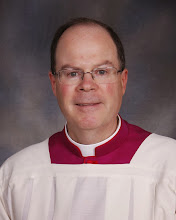Sunday, March 3, 2013
Mass for First Scrutiny
We were delighted to have the Archbishop of Ottawa as the celebrant and homilist at the 9 a.m. Mass this Sunday. But while we were planning his visit, Archbishop Terrence Prendergast sent me an e-mail to say he hoped his homily wouldn't interrupt the flow of the Lenten themes on which I was preaching.
I didn't know what to say—the last time I thought about having an overall theme for my homilies was 25 years ago, which was the last time I had time!
However, since Archbishop Prendergast is a respected Scripture scholar who approaches preaching very seriously, his comment encouraged me to take a good look at the overall structure of the Gospels we'll hear at the 11 o'clock Mass for the rest of Lent, at which we celebrate the scrutinies—special rites marking the progress of those preparing for baptism at Easter.
What I found when I read today's Gospel together with those of the next two Sundays can be summed up in these words from the Sunday missal* I bought in Rome nearly thirty years ago:
This Sunday, and the following two Sundays, the liturgy "brings to life the great stages by which those preparing for baptism were—and are—helped to discover the profound demands of conversion to Christ, by the signs of water, of light, and of life."
There's a Lenten theme for you, one we can remember in just three words: water, light and life. The catechumen's journey is, of course, our journey too as we strengthen our own conversion and prepare to renew the vows of our own baptism.
In today's Gospel--the first of the three Gospels used from ancient times during pre-baptismal rites--water becomes a symbol that stands for man's request and God's response. Humanity has great thirsts--we thirst for love, for understanding, for justice, for peace. Yet these deep desires of our hearts are all too often not satisfied; the world responds to what we seek only in fragmented ways, if at all.
And so from the depths of our being we call for more—for something that will truly quench our thirst and give our hearts what they long for. But like the woman at the well, we ask "where do you get that living water?" Where can we find water that satisfies and fulfills our deepest desires?
Jesus answers the question. He answered it for the Samaritan woman and he answers it for us.
Indeed, the answer is found not only in today's Gospel but throughout the Bible. The Lord says through the Prophet Jeremiah "my people... have forsaken me, the fountain of living water", while in his vision of the heavenly Temple the Prophet Ezekiel sees water flowing in Paradise.
In our first reading today, Moses brings forth water for the parched Israelites by striking a rock. In his first letter to the Corinthians, Paul tells us clearly that "the rock was Christ."
Jesus himself is the source of the water of the Spirit, the wellspring of the love "poured into our hearts through the Holy Spirit that has been given to us," as St. Paul writes in our second reading
These Lenten Sundays lead catechumens throughout the world to the celebration of Holy Week and Easter, when we see the promise of living water fulfilled for all time. Water and blood flowed from the side of the crucified Lord, giving birth to the Church who gives birth to generations of God's children through the waters of baptism.
Also at Calvary we hear Jesus himself say "I thirst." That very human cry from the Cross reminds us that Christ longs for our love and friendship—indeed, that he longs for us.
Water, light and life. Today the woman at the well. Next Sunday, light to the eyes of a man born blind. The Sunday after that, life restored to Lazarus.All signs for us who thirst, who live in shadow, who fear death. All signs of the overflowing goodness of God.
Water, light and life. Three things needed for human existence; three symbols of our spiritual needs. So how do we receive these gifts from God? There's a common answer in all three of the year A Gospels we read during the Masses at which the scrutinies are celebrated. In all three Gospels, there's some dialogue with Jesus. People talk to him and express their deepest needs.
The woman at the well asks for the living water as soon as Jesus tells her about it. The disciples ask Jesus "who sinned?", the man born blind or his parents, confused as they are by human suffering. And Mary tells Jesus that Lazarus would not have died if only he'd arrived sooner.
As Lent continues, we also need to talk to Jesus and express our thirst and hunger; we need to ask him for the gifts already promised us in the water of baptism: the light of life, and the fire of divine love. He thirsts to give us nothing less.
-----------
* Not sure if they're still in print, but the daily and weekly Messale dell'Assemblea Cristiana published by the Centro Catechistico Salesiano (Edizioni Di Ci) are treasures for those who can read Italian. I relied heavily on the Sunday missal for this homily.
Subscribe to:
Post Comments (Atom)


I have always appreciated the thematic approach. For someone in the pew, it connects to past sundays, anticipates future sundays, and gives me something more to walk away with. I like the nugget you have boiled it down to here.
ReplyDeleteShawn
Thanks, Shawn, though the real credit goes to one of the anonymous Italian Salesians who contributed to my missal!
ReplyDelete